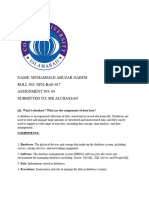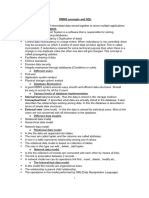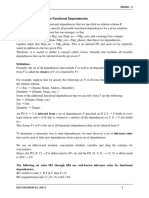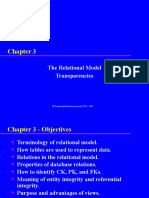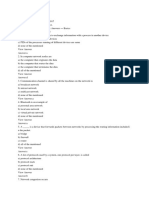Notes of Database
Uploaded by
ritikaop110Notes of Database
Uploaded by
ritikaop110What is a Database?
Database is a systematic collection of organized data or
information typically stored on a electronic media in a computer
system. With database data can be easily accessed, managed,
updated, controlled and organised.
Many website on the world wide web widely use database system
to store and manage data (commonly referred as backend).
Advantages of Database
Minimize Data Redundancy: In traditional File processing system
same piece of data may be held in multiple places resulting in
Data redundancy (duplicacy). Database system minimizes
redundancy by data normalization.
Increased Data consistency: When multiple copies of same data
do not match with one another is called as data inconsistency.
Data Security: Database allows only the authorized user to access
data in the database.
Data Sharing: Database allow its users to share data among
themselves.
Data Integrity: Data in the database accurate and consistent.
Database Management System (DBMS)
A DBMS refers to a software that is responsible for storing,
maintaining and utilizing database. Some examples of the popular
database software include MySQL, Microsoft Access, Microsoft SQL
Server, FileMaker Pro, Oracle Database, and dBASE.
Data Model:
A data model is the way data is organised in a database. There
are different types data models controls the representation of
data in a database, these are:
•Relational Data model
•Network Data Model
•Hierarchical Data Model
•Object Oriented Data Model
The Relational data Model is far being used by most of the popular
Database Management Systems. In his course we limit our
discussion on Relational data model.
Relational Data Model
In Relational data model data is organized into tables( rows and
columns). Tables in a relational model is called as Relations. Each
row of a relation represents a relationship between all the values
in the row.
Relational Database:
A relational database is collection of multiple data sets organised
as tables. A relational database facilitates users to organize data
in a well defined relationship between database tables/relations.
It uses Structured Query Language(SQL) to communicate with the
database and efficiently maintain data in the database.
Relation & Associated Terminologies
Relational Database Terminologies
Tuple/Record: In Relational Database, rows in the Relation/Table
are referred as records
Attributes/Fields: Columns are referred as Attributes/Fields.
Cardinality: Total number of records in the relation is called as its
Cardinality.
Degree: Total number of Attributes/Fields in the relation is called
as its Degree.
Domain: permitted range of values of an attribute for an entity.
Primary key: The attribute or the set of attributes that uniquely
identifies records in a relation is called as the Primary key of the
Relation.
Types of Keys:
Candidate Key: A Candidate key is a attribute/set of attributes
that uniquely identifies tuples in a relation. A relation may be
more then one candidate key.
Primary Key: A Primary key is a attribute/set of attributes that
uniquely identifies tuples in a relation. All the values in the
primary Key need to be unique and NOT NULL.
Among all the candidate keys the Database Administrator(DBA)
selects one as Primary key. A relation may have multiple
Candidate Keys but ONLY ONE Primary Key.
Alternate Key: A alternate is basically is/are those candidate key
which is/are not used as Primary key of the relation.
Foreign Key: Foreign key is a attribute of a relation(called as Child
table) that referes to the Primary Key of another relation(called as
parent table).
You might also like
- Database Management System Using LibreOffice BaseNo ratings yetDatabase Management System Using LibreOffice Base18 pages
- Ln. 3 - Relational Database Management system grade 10 CBSENo ratings yetLn. 3 - Relational Database Management system grade 10 CBSE19 pages
- Introduction to Database Management SystemNo ratings yetIntroduction to Database Management System14 pages
- Relational Databases: Rishu Kaul Computer Science DepartmentNo ratings yetRelational Databases: Rishu Kaul Computer Science Department16 pages
- Database and Database Management SystemNo ratings yetDatabase and Database Management System8 pages
- Chap-11 Relational Databases Notes Class 12No ratings yetChap-11 Relational Databases Notes Class 1212 pages
- Relational Database Management Systems (Basic)No ratings yetRelational Database Management Systems (Basic)18 pages
- Chapter 8 Introduction of Database Management SystemNo ratings yetChapter 8 Introduction of Database Management System4 pages
- Relational Database Management System: by Fitwi KebedeNo ratings yetRelational Database Management System: by Fitwi Kebede48 pages
- Veritabanı Yönetim Sistemleri YZM508: Dr. Osman GÖKALPNo ratings yetVeritabanı Yönetim Sistemleri YZM508: Dr. Osman GÖKALP49 pages
- Chapter 6: Entity-Relationship Model: Database System Concepts, 5th EdNo ratings yetChapter 6: Entity-Relationship Model: Database System Concepts, 5th Ed82 pages
- Inference Rules For Functional Dependencies: F (SSN (Ename, Bdate, Address, Dnumber)No ratings yetInference Rules For Functional Dependencies: F (SSN (Ename, Bdate, Address, Dnumber)12 pages
- MODULE 2: Relational Model: Prepared by Sharika T R, SngceNo ratings yetMODULE 2: Relational Model: Prepared by Sharika T R, Sngce201 pages
















































